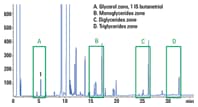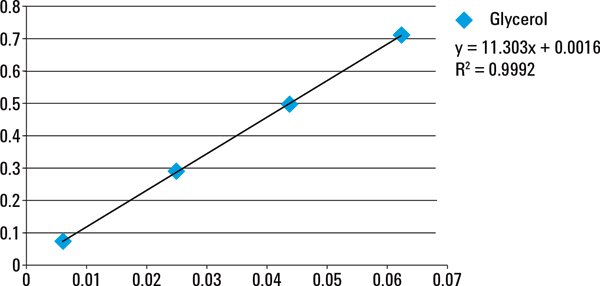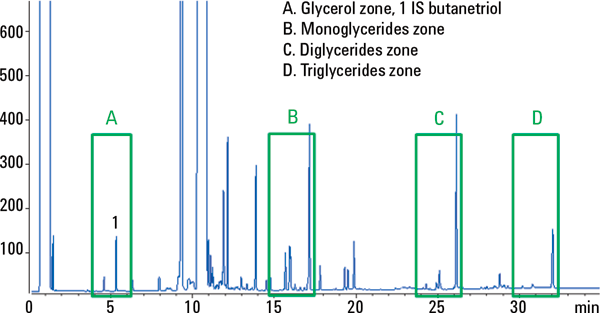Access Agilent eNewsletter, August 2014
>> Update My Profile | Subscribe to Access Agilent | Article Directory

Agilent solutions for biofuels and alternative energy
By Wayne Collins
Agilent Energy & Chemicals Marketing Manager
Global warming, trade deficits, environmental concerns, political instability, and security of international supply lines are driving dramatic changes in the energy and chemical industries. Today’s world is looking for reliable, clean, and sustainable energy sources – and is turning to biomass as an answer.
Biomass is any plant or animal material of recent origin, as opposed to plant or animal material that, over millennia, has transformed into oil, coal, tar sands, natural gas, or other petroleum products. Although there are numerous technologies under development for converting biomass to fuels and chemicals, they all follow the same basic procedure, from feedstock through transformation to final product. Feedstock includes maize, algae, sugar cane waste, grasses, tallow, and wood. These raw materials are converted to final product using catalysis, chemical extraction, combustion, fermentation, enzymic transformation, or pyrolysis, among others. The final biomass products include biodiesel, butanol, ethanol, ethylene, or synthesis gas.
Techniques and tools for biomass product analysis
For biomass products to compete with petroleum, they must conform to industry requirements throughout the manufacturing chain. The four main areas of analysis are:
- Raw material quality: carbohydrate, protein, and fat assays directly impact the market price of biomass feedstock.
- Process control: measuring the conversion to fuel during plant production is critical for optimizing economics.
- Fuel product certification: recognized quality standards must be met before the final product enters the fuel supply.
- Field operations/monitoring: the blending of biofuel into traditional petroleum products must be monitored at terminals – and advertised content must be enforced at the point of sale.
Given the complex nature of biomass feedstock, it is not surprising that a whole range of analytical techniques can be used.
- HPLC systems are ideal for assessing carbohydrate quality and production
- GC biofuel analyzers are used to demonstrate that final products conform to industry quality standards
- Fourier Transform Infrared spectroscopy (FTIR) is the preferred technique for identifying unknowns such as quantifying biodiesel in diesel fuel
- MP-AES is an excellent tool for the elemental analysis of biofuels, from feedstock process monitoring to quality control
- Automated sample prep WorkBench for GC and LC reduces analysis time and labor costs, as well as minimizing variability between tests and decreasing sample carryover
 Enlarge
Enlarge
Figure 1. Linearity response for glycerol using the Agilent MMI.
 Enlarge
Enlarge
Figure 2. B100 biodiesel with internal standards kit solutions showing the zones of interest, separated on an Agilent J&W Select Biodiesel for Glycerides GC column.
Find more details on Agilent’s comprehensive range of solutions to sustain biomass product quality in our Biomass Solutions brochure. Alternatively, seek out Agilent biofuel Application Notes – one of which is highlighted below.
Simplified measurement of glycerols in biodiesel
B100 biodiesel is a cleaner-burning alternative fuel produced from renewable resources such as plant oils. It can be assayed for free and total glycerol content using a cool on-column inlet according to industry standard method DIN EN 14105:2011-07. However, the Agilent multi-mode inlet (MMI) can be used in place of cool on-column for this assay, with a high degree of confidence. Figure 1 shows that the linearity was excellent for the range of concentrations required by the assay, and Figure 2 displays the glycerin zones of interest in a sample of B100 biodiesel.
By employing the Agilent J&W Select Biodiesel for Glycerides GC column with UltiMetal and test solutions, the task of quantifying biofuel glyceride content is greatly simplified. Read the full story in Agilent Application Note 5991-3224EN.
Comprehensive range of biomass solutions to explore
Since the majority of tests on biomass are likely to be performed by non-scientific personnel, analytical instruments must be fast, accurate, safe, and easy to operate. You can count on Agilent for the technical capabilities and expertise you need to meet these difficult analytical challenges. See what Agilent biofuels and alternative energy solutions for can do for you.
>> Update My Profile | Subscribe to Access Agilent | Article Directory

